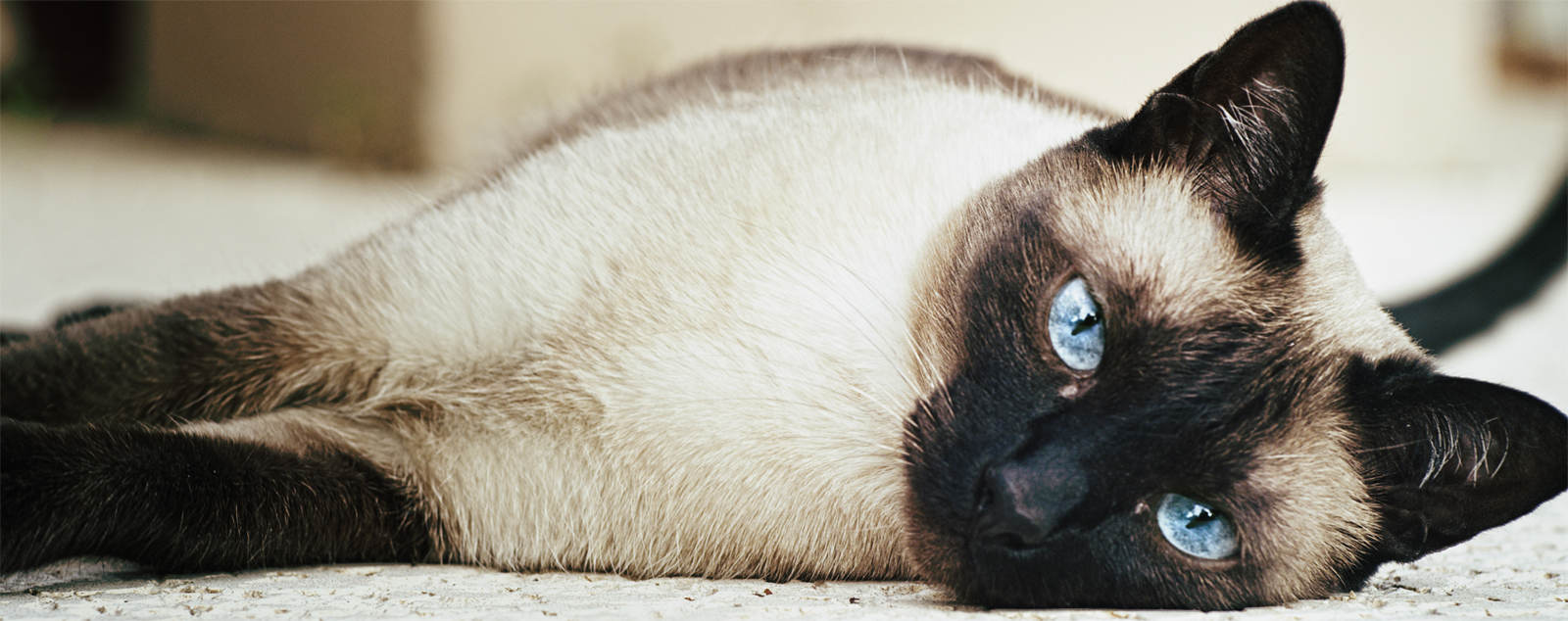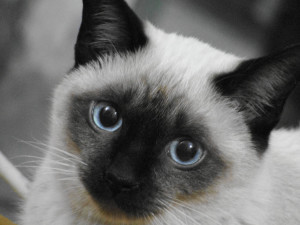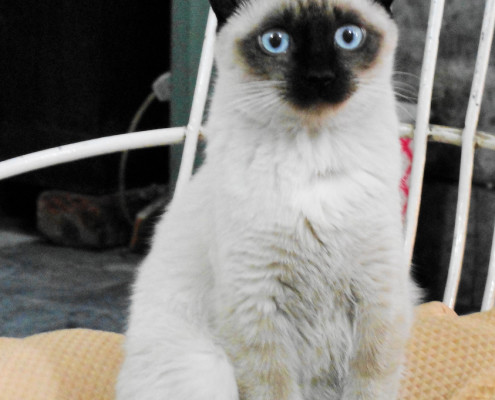Thai

Meoww!!
The Thai is a medium size cat with a lithe graceful body. It looks pretty much the same as the Traditional (Old-Style) Siamese, and this is how the breed is sometimes referred to. The unique feature of Thai cats is the shape of their head – the forehead is long and flat.
In 5 Words
- Highly intelligent
- Active
- People-orientated
- Chatty
- Affectionate
Snapshot
Size: Medium to Large
Weight:
Males weigh from 10 to 15 pounds and
Females weight between 8 and 12 pounds
Origin: Thailand
Life Span: 15 years or more
Colour: Any point color and solid points, tabby points, tortie points, or torbie points. White markings are not permitted.

Characteristics
Learn About the Thai
The first Thai cats were brought to Great Britain in 1886 by the English ambassador in Bangkok, Mr. Owen Gould, as a gift to the royal family. Cats from that time were also known as Royal Cats from Siam. Compared to present day Siamese, they were bigger, of a more robust build, with rounder heads. Through gradual breeding, the Siamese cat was bred to its present day characteristics: a long triangular head, extremely slender body and long legs. Due to a growing interest in the original, more robust type, English breeders started selecting cats from 1958 on for breeding in order to achieve the original appearance and qualities of cats first brought from Thailand.
In the early 1990s a pioneering German woman introduced a Siamese cat that represented the classic look of the Old-style Siamese to the show halls in Europe. She called the cat “Thai.” Her dedication to revitalizing the old look using Siamese bloodlines inspired European breeders to begin breeding and showing a cat called “Thai.” As a result, numerous independent clubs developed their own breed standards so their members would promote these cats. The Thai began to diverge from the Siamese breed in the 1950s, when breeders around the world chose to breed Siamese of the moderate, early 20th century type. By the 1980s, moderate type Siamese were no longer competitive at shows, as mainstream breeders were breeding a much typier, more extreme cat.
In the 1980s, the first breed clubs dedicated to the old-style Siamese appeared in Europe and North America. In 2006 a proposal went forward to recognize the Old-style Siamese as “Thai” in The International Cat Association (TICA), and proponents of the old look met in Hannover, Germany, to introduce the Thai breed proposal. From 2007–2010 this very old breed moved through the New Breed process in TICA, requiring documentation of active breeders, registration of cats and litters and showing cats in many different regions. On January 20, 2010, the TICA board voted to advance the Thai to Championship status beginning on May 1, 2010. On that date, the Thai began competing along with the other breeds in TICA Championship classes.
The Thai is a medium size cat with a lithe graceful body. It looks pretty much the same as the Traditional (Old-Style) Siamese, and this is how the breed is sometimes referred to. The unique feature of Thai cats is the shape of their head – the forehead is long and flat. This trait is used to distinguish the breed from other pointed cats. The head is wide with rounded sides. The muzzle is wedge-shaped. At the cheekbones, there’s a slight curve inward to where the muzzle begins.
Then, the muzzle tapers gradually toward the nose. The face is heart-shaped. The round eyes are deep blue and are brilliant and luminous. The ears are medium to large in size, wide at the base with oval tips. The body is muscular, slender and elegant. The legs are medium in length with rounded paws. The tail is medium and tapers slightly to a point. The coat is silky with very little undercoat. The face, ears, paws and tail are all dark while the rest of the body is light.
The Thai is a highly intelligent, active and people-orientated cat. They are great chatters and will often talk to you in yowls and yips. Greeting you at the door is a usual thing. They are high maintenance cats when it comes to affection and attention. Living with a Thai is like living with a small child: they will jump onto the top of your favourite wall-mounted clock and balance there, teetering, just to see if they can. Thais are great talkers. They aren’t necessarily loud, but they’re chatty.
They will greet you at the door when you come home and start chatting away. They also communicate with taps of the paw or by jumping to the top of your shoulder and putting their face right in yours. They will need a response and daily attention from you. Without it, they will suffer, and suffering, they will act out. The Thai like the Siamese, can be a very vocal cat who likes to let its owner know exactly what is on his mind, though some rarely ‘talk’. Their voices can be similar to the Siamese, while others have soft gentle meows.
The Thai cats can be prone to developing cross-eyes and kinked tails, but these are merely physical problems that has no impact on their longevity. Otherwise, the breed is naturally healthy.
The coat of Thais is short, soft, silky to the touch. It’s neither tight nor slick like glass, nor does it feel plush. Little grooming is necessary because Thais tend to keep themselves very clean.
Thais come in any point color and solid points, tabby points, tortie points, or torbie points. White markings are not allowed in show cats.






